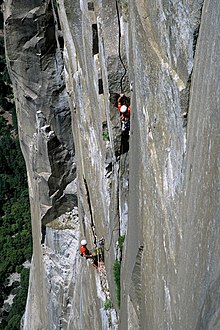| Part of a series on |
| Climbing |
|---|
 |
| Lists |
| Types of rock climbing |
| Types of mountaineering |
| Other types |
| Key terms |
Multi-pitch climbing is a type of climbing that typically takes place on routes that are more than a single rope length (circa 50 to 70 metres) in height (or distance), and thus where the lead climber cannot complete the climb as a single pitch. Where the number of pitches exceeds 6–10 (300–500 metres), it can become big wall climbing, or where the pitches are in a mixed rock and ice mountain environment, it can become alpine climbing. Multi-pitch rock climbs can come in traditional, sport, and aid formats. Some have free soloed multi-pitch routes.
Multi-pitch climbing is more complex and riskier than single-pitch climbing as the climbers will remain exposed on the route (e.g. a rock climbing route, an ice climbing, or a mixed climbing route) for longer, and it will often involve the use of hanging belays, long abseils, and the creation of belay anchors. Rescues from multi-pitch climbs are far more serious, and climbers will use additional protection to avoid this. Multi-pitch climbing requires greater communication between climbers; advanced climbers can use the riskier—but faster— simul climbing.
|
See also: Lead climbing § Multi-pitch leading |
Multi-pitch lead climbing involves ascending routes that cannot be completed in a single pitch (often a rope-length), usually due to their height but sometimes due to routes that move in unusual directions. Multi-pitch routes are more commonly traditional climbing routes (i.e. the leader inserts the climbing protection as they ascend), but there are also multi-pitch sport climbing routes (i.e. the climbing protection is pre-bolted into the route, or at least where important belay anchors are pre-bolted such as on El Capitan in Yosemite).[1][2]
Multi-pitch climbs are usually done in pairs, and the position of leader can alternate between pitches or after a group of pitches if both climbers can lead the route; alternatively, one climber can lead all of the pitches. Where both climbers are very comfortable on the terrain and want to move quickly, they can use simul climbing, although this is a more complex and riskier technique. Multi-pitch climbs can be done as solo climbs, either as free solo climbing (i.e. no protection used), or as rope solo climbing (i.e. a self-belying system used).[1][2]
The boundary between multi-pitch climbing and big wall climbing or alpine climbing is not defined. Generally, multi-pitch routes that are at least 6–10 pitches or 300-500 metres in length, and mostly require hanging belays (i.e. due to the sheer nature of the route) are considered "big wall routes". Long multi-pitch climbs on mountains whose route is not continually on a sheer "big wall" face, are sometimes referred to as alpine rock climbing. Ice climbing and mixed climbing can also be done as multi-pitch climbing, or as part of an alpine climbing route.[1][2]
|
See also: Rock-climbing equipment |
Multi-pitch climbing requires all the equipment used in leading a single-pitch sport, traditional or ice climbing route, but with a few specific additions:[1][3]

While many of the techniques of single-pitch lead climbing are common to multi-pitch climbing, there are specific techniques that are important to be able to execute well to safely ascend a multi-pitch climbing route:[1][3]
|
See also: Sport climbing § Grading, Traditional climbing § Grading, and Ice climbing § Grading |
|
See also: Big wall climbing § Grading, Alpine climbing § Grading, and Aid climbing § Grading |

Multi-pitch routes are graded in the same way as single-pitch sport route grading, traditional route grading, or ice route grading, depending on the route. Each individual pitch will be graded so that, for example, a 3-pitch multi-sport climbing route might be graded as French sport: 7c, 7b, 8a; or a 5-pitch multi-traditional climbing route might be graded as American YDS: 5.10a, 5.10b, 5.10a, 5.11c, 5.9. Harder or easier options on individual pitches will also be highlighted and separately graded, so that, for example, a pitch might be graded as French sport: 7c "avoidable" or "max" (you don't have to do the 7c part) / 7a "obligatory" or "obj" (you will have to do at least 7a graded climbing).[14]
Sometimes an "overall" grade is quoted for the multi-pitch climb (in addition to the grades of the individual pitches), however, this is usually the grade of the hardest pitch on the route (e.g. see Yeah Man image opposite).[14]
In common with big wall grading, where there are very difficult sections of individual pitches that are well above the general level of difficulty of the overall route (i.e. a common feature of bigger walls as it is harder to find big routes of a consistent difficulty level), an aid climbing option might be highlighted, which will have an attached aid climbing grade, for example, an individual pitch on a multi-traditional climbing route might be graded as: 5.10a (with no aid) or 5.7 A2 (with aid), and the type of aid needed also explained.[14]
A number of notable films have been made focused on multi-pitch (and big wall climbing) including:[15]